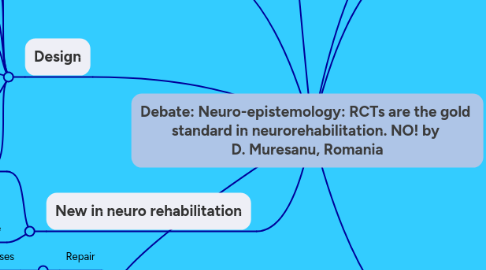
1. RCT's are the gold standard in neurorehabilitation: position NO
2. making decisions based on evidence
2.1. How to apply generatlisations to individuals?
2.2. Feinstein AR. The problem of cogent subgroups: a clinicostatistical tragedy j clin epidemio
2.3. Link to Paper
3. RCT
3.1. Internal validity
3.1.1. pocock sj clinical trials a practical approach, chichester, john wiley 1983
3.1.1.1. Link to Paper
3.1.1.1.1. (publishers' site)
3.1.2. Friedman LM fundamentals of clinical trials 3rd edn. springer 1998
3.1.2.1. Link to review of book
3.2. external validity
3.2.1. often limited
3.2.1.1. jacobson ebm and general practice 1997
3.2.1.1.1. Link to paper
3.2.1.2. david smith
3.3. No accepted guidelines on how external validity of rct's should be assessed
3.3.1. limitations of evidence j r coll physicians
3.4. One explanation for widespread underuse
3.5. External validity needs clinical rather than statistical review
3.6. The "Gulf"
3.6.1. Volker Homberg, 6th SSNN congress
3.6.2. RCT results are not applicable to small heterogenous samples
3.6.3. problems with subgroup analyses
3.6.4. not all relevant information is used in MA
3.6.5. individual dispositions for treatment responsivity
3.6.6. very expensive
3.7. How to bridge the "Gulf"
3.7.1. derive the elemntary rules from basic science
3.7.2. apply such elementary rules to invent therapeutic procedures for individual use
3.7.3. re-evaluate in more sophisiticated RCTs theses therapeutical approaches for individual use
4. In practice
4.1. Repair
4.1.1. Endogenous basic biological processes
4.2. Damage
4.2.1. Pathophysiological processes
4.3. Inflammatory mechanisms after ischemia and stroke, Danton GH, J. Neuropath Exp
4.3.1. Link to paper
5. Meeting notes by
5.1. Paul de Roos
5.1.1. www.twitter.com/paulderoos
5.1.2. www.paulderoos.com
5.2. Mindmap hosted on
5.2.1. www.neurologytraining.eu
5.2.1.1. Twitter:
5.2.1.1.1. www.twitter.com/trainneurology
5.3. Meeting
5.3.1. Controversies in Neurology
5.3.1.1. Linkt to website
5.3.2. Meeting Overview mindmap
5.3.2.1. Link to mindmap
6. New in neuro rehabilitation
6.1. learning by imitation
6.1.1. role of mirror neurons!
6.2. imagination and mental practice
6.2.1. focusing attention and self induced neuroplasticity
6.2.2. Schwartz 2002 the mind and the brain
6.2.2.1. Book @ Amazon
6.2.3. quantum physicis in neuroscience and psychology: a neurophysical model
7. Design
7.1. randomised
7.2. controlled
7.3. multiple
7.4. crossover
7.5. trial
7.6. patient serves as it's own control
7.7. well conducted n of 1 trials to individualize therapy has led to a recent revision of the hierarchy of evidence for interventions, placing the n of 1 trial at the top of the levels of evidence
7.7.1. improving treatment compliance in large RCTs
7.7.2. refining estimates of treatment effectiveness in populations and individuals
7.7.3. the information acquired from other patients' responses in nof-1 trials can also be used to aid other patietns
